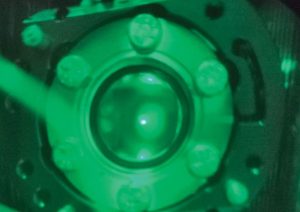
With modern technological developments, it is now possible to make atomic structure measurements with unprecedented accuracy and precision. The development of laser cooling and trapping for Doppler free spectroscopy and frequency combs for absolute frequency measurement are tools that did not exist until quite recently, but enable measurements of atomic structure that can go significantly beyond what was feasible in the past. Absolute accuracies below 1 kHz are possible.
In our lab, we use a magneto-optical trap (pictured in Fig. 2) to cool and capture cesium atoms. We excite the cesium atoms to Rydberg states in an environment free of low frequency electric and magnetic fields. We detect the Rydberg atoms using time-of-flight spectroscopy by ionizing them and projecting them onto a charge sensitive detector, one at a time. The excitation lasers are locked to a frequency comb. The frequency comb allows us to determine the frequency of the lasers to very high precision. The experimental setup allows us to measure Rydberg levels with very small absolute error, referenced to the ground state of the cesium atom.
Funding agencies:
Interested in Collaborating or Joining Our Team?
If you are interested in collaborating with us or becoming a technical staff member, including student internships and postdoctoral training, please contact James Shaffer at [email protected].
